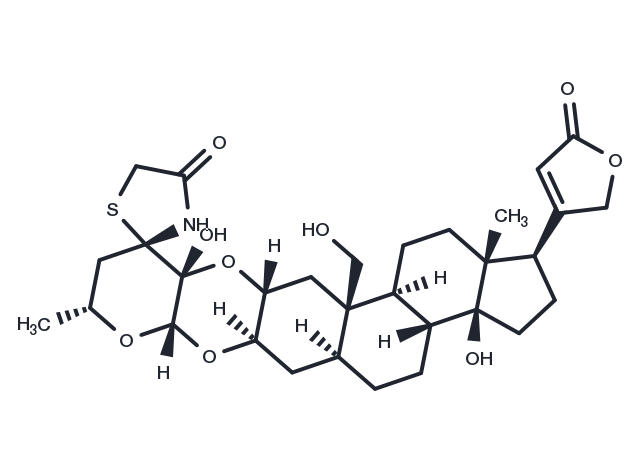Powder: -20°C for 3 years | In solvent: -80°C for 1 year


UNBS-1450 is a sodium channel antagonist. UNBS-1450 is a hemi-synthetic cardenolide derived from 2″-oxovorusharin, it is effective against various cancer cell types with an excellent differential toxicity. At low nanomolar concentrations, UNBS-1450 induces apoptotic cell death. UNBS-1450 inhibits NF-κB transactivation and triggers apoptosis by cleavage of pro-caspases 8, 9 and 3/7, by decreasing expression of anti-apoptotic Mcl-1 and by recruitment of pro-apoptotic Bak and Bax protein eventually resulting in cell death.

| Pack Size | Availability | Price/USD | Quantity |
|---|---|---|---|
| 25 mg | 5 days | Inquiry |
| Description | UNBS-1450 is a sodium channel antagonist. UNBS-1450 is a hemi-synthetic cardenolide derived from 2″-oxovorusharin, it is effective against various cancer cell types with an excellent differential toxicity. At low nanomolar concentrations, UNBS-1450 induces apoptotic cell death. UNBS-1450 inhibits NF-κB transactivation and triggers apoptosis by cleavage of pro-caspases 8, 9 and 3/7, by decreasing expression of anti-apoptotic Mcl-1 and by recruitment of pro-apoptotic Bak and Bax protein eventually resulting in cell death. |
| Synonyms | UNBS 1450, UBS1450, UBS-1450, UBS 1450 |
| Molecular Weight | 605.74 |
| Formula | C31H43NO9S |
| CAS No. | 676541-58-5 |
Powder: -20°C for 3 years | In solvent: -80°C for 1 year
You can also refer to dose conversion for different animals. More
bottom
Please see Inhibitor Handling Instructions for more frequently ask questions. Topics include: how to prepare stock solutions, how to store products, and cautions on cell-based assays & animal experiments, etc.
UNBS-1450 676541-58-5 UNBS 1450 UNBS1450 UBS1450 UBS-1450 UBS 1450 inhibitor inhibit
